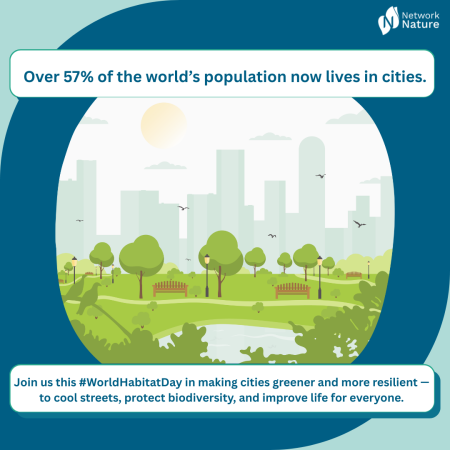
When we think of urban crises, we often imagine floods in coastal cities or heatwaves in drought-stricken regions - problems that seem far removed from our own neighbourhoods. However, the reality is that cities everywhere are facing urgent challenges, ranging from social inequalities to biodiversity loss. With over 57% of the global population now living in cities - a figure expected to rise to almost 67% by 2050, the stakes for urban areas are higher than ever. When crises such as heatwaves, floods, or biodiversity loss hit, they affect millions of people at once because so much of the world’s population, infrastructure, and economic activity is concentrated in cities. This makes it critical to ensure that cities are not only prepared for these challenges but can also adapt and thrive in the face of them.
This World Habitat Day, NetworkNature highlights the crucial role of nature in times of crisis not only in our cities but for nature overall. In urban areas, green spaces cool our cities, store carbon, filter water, and provide vital habitats for biodiversity, while also contributing to the well-being of residents. However, the impacts of climate change and rapid urbanisation threaten these benefits, making it urgent to design places to live that remain liveable and resilient. Nature, including the soil beneath our feet, can help us achieve this.
Healthy ecosystems are a key component of resilient urban habitats, and the importance of soils in particular should not be underestimated: they host 59 % of global biodiversity, regulate water, store carbon, and provide the foundation for urban ecosystems.
“Facing common city challenges such as heat, densification and competition for land, Mannheim harnesses an integrated approach using synergies of greening, sustainable construction and pollution-free environment measures to improve urban nature and quality of life.” - Frida Brett-Smith, City of Mannheim
As an example, Mannheim is actively engaging with these goals. Located at the confluence of the Rhine and Neckar rivers, the city is advancing projects such as its Local Green Deal, the Municipal Biodiversity Strategy, and EU initiatives like Commit2Green and UNP+ to strengthen climate adaptation, biodiversity, and social inclusion. Former industrial areas are being transformed into green corridors, riverbanks are being restored, and natural spaces woven into dense urban districts - fostering resilient city habitats. Another key element in this transformation is soil health: Mannheim’s Soil Protection Authority identifies and remediates contaminated sites, providing the foundation for safely and sustainably converting former industrial areas into climate-resilient green and recreational spaces. Around half of Mannheim’s area already consists of parks, forests and wetlands. These range from the historic Luisenpark to the 80-hectare Spinelli nature reserve, with new green spaces being added where they are most needed. These efforts are centred on citizen participation: online platforms, workshops, and the city’s Participation Advisory Board ensure that residents, NGOs, scientists, and municipal departments help shape projects from the outset. By combining innovation, ecological restoration, and community engagement, Mannheim shows how cities with an industrial past and a thriving economic present can transform into liveable, climate-resilient, and nature-rich urban spaces.
In Europe, these efforts are further reinforced by the EU policy framework. The EU Directive on Soil Monitoring and Resilience establishes a legal framework for sustainable soil management and monitoring, while the EU Nature Restoration Regulation sets broader objectives for restoring urban ecosystems and implementing nature-based solutions across cities. Together, these policies provide cities with both practical tools and regulatory guidance to foster healthy, resilient urban habitats.
Learn more about how NbS initiatives are working with these policies such as SPADES, the Berlin Urban Nature Pact, and SoilTRIBES to support cities in promoting soil-friendly urban planning and innovative restoration approaches.
- SPADES - Diagnostic Workbook, a practical guide for integrating soil health into spatial planning.
- The Berlin Urban Nature Pact outlines 28 specific, measurable targets across seven key areas - such as green and blue infrastructure, soil health, and biodiversity education - to guide cities in reversing biodiversity loss and fostering nature-positive urban environments by 2030. Get inspired!